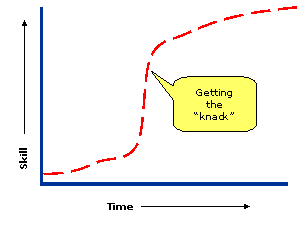Gestalt
(Plural „Gestalten”) is German for “pattern”, “figure”, “shape”, or “form” It originates from the work of Max Wertheimer and his students Köhler and Koffkabut not precisely translatable, just as „Angst” is not. It is used to refer to wholes, systems and complete structures rather than the reductionist approach of seeking ever smaller components of a phenomenon. In learning, opposed to the reductionism of behaviourism, it concentrates on the way in which the mind insists on finding patterns in things, and how this contributes to learning, especially the development of “insight”.
Classic Gestalt image
|
|
A vase or two faces? It's easy to see one or the other: almost impossible to see neither, or indeed both at the same time. The classic Gestalt phenomenon is that of figure versus ground. Which is the image and
which the background? |
|
What is it (1)? (Hover on the picture for the answer) |
|
|
|
What is it (2)? |
The point of these rather silly examples is to note the usual reaction when you work them out: there is, however trivial, a release of tension because it has been possible to assimilate a previously non-sensical image into a frame of reference. Gestalt emphasises that the mind abhors non-sense.
It is clear that some kind of cognitive re-structuring has taken place, which may then become apparent in behaviour, but seemingly precedes that behaviour. Someone has "understood" differently, so that their capacity for potential action has changed, even if that action or behaviour is not immediately manifest. Exactly what is going on in the brain we do not yet know, but there have been considerable advances in recent years (even since the first edition of this site in 2002), and neuroscience is a hot topic nowadays. (I am continuing to search for web resources in this field which are both reliable and accessible. Few are both. In the meantime see Zull, 2002 and Johnson, 2005)
The importance of the theory for real-world learning is the attention which it draws to wholes (and incidentally to problem-solving as a part of learning). Whereas behaviourism concentrates on breaking down a task into parts and how each is learned individually and incrementally, Gestalt acknowledges the “knack” element. It thus underpins all the cognitivist theories.
A "knack" is a psychomotor equivalent of cognitive "insight": the best example is probably learning to ride a bicycle. The learning "curve" (where x=time and y=skill) is more like a single step. The learning happens in a few moments, and is permanent—although it may have taken a long time to get to that step with little seeming progress.

Experimental work on Gestalt learning is primarily about the problem-solving capacities of animals: chimps spontaneously pile up boxes in order to climb on them to reach bananas, for example (Köhler, 1925). The learning element is shown by their ability to repeat the action later, without apparently having to pause and think about it as they did the first time. However, recent experiments have shown Betty the crow doing something just as ingenious and remarkable;
It also contributes to an account of some of the difficulties people have with learning: Gestalten (similar to schemata, in a different discourse), once formed, are not easily dislodged or replaced.
More about the crows here See also the associated but broader notion of "threshold concepts", which comes at similar ideas from the properties of the concepts, rather than the psychology of the learner
Assimilation and Accommodation Cognitive dissonance Resistance to Learning
Atherton J S (2013) Learning and Teaching; [On-line: UK] retrieved from
Original
material by James Atherton: last up-dated overall 10 February 2013 
This work is licensed under a Creative Commons Attribution-Noncommercial-No Derivative Works 3.0 Unported License.
Search Learningandteaching.info and associated sites:
![]() Save this on Delicious Tweet
Click
here to send to a friend
Save this on Delicious Tweet
Click
here to send to a friend

This site is independent and self-funded, although the contribution of the Higher Education Academy to its development via the award of a National Teaching Fellowship, in 2004 has been greatly appreciated. The site does not accept advertising or sponsorship (apart from what I am lumbered with on the reports from the site Search facility above), and invitations/proposals/demands will be ignored, as will SEO spam. I am of course not responsible for the content of any external links; any endorsement is on the basis only of my quixotic judgement. Suggestions for new pages and corrections of errors or reasonable disagreements are of course always welcome. I am not on FaceBook or LinkedIn.


